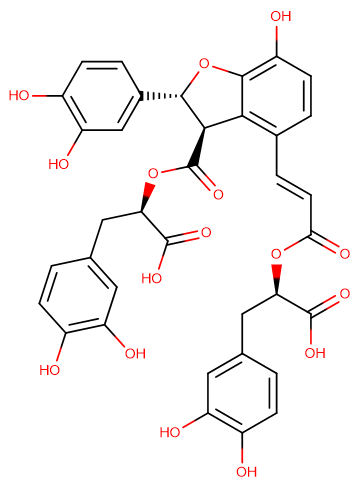
Salvianolic acid B
CAS No. 115939-25-8
Salvianolic acid B( —— )
Catalog No. M10551 CAS No. 115939-25-8
Salvianolic acid B is an active pharmaceutical compound present in Salvia miltiorrhiza, exerts a neuroprotective effect in animal models of brain and spinal cord injury.
Purity : >98% (HPLC)
 COA
COA
 Datasheet
Datasheet
 HNMR
HNMR
 HPLC
HPLC
 MSDS
MSDS
 Handing Instructions
Handing Instructions
| Size | Price / USD | Stock | Quantity |
| 10MG | 57 | In Stock |


|
| 25MG | 105 | In Stock |


|
| 50MG | 162 | In Stock |


|
| 100MG | Get Quote | In Stock |


|
| 200MG | Get Quote | In Stock |


|
| 500MG | Get Quote | In Stock |


|
| 1G | Get Quote | In Stock |


|
Biological Information
-
Product NameSalvianolic acid B
-
NoteResearch use only, not for human use.
-
Brief DescriptionSalvianolic acid B is an active pharmaceutical compound present in Salvia miltiorrhiza, exerts a neuroprotective effect in animal models of brain and spinal cord injury.
-
DescriptionSalvianolic acid B is an active pharmaceutical compound present in Salvia miltiorrhiza, exerts a neuroprotective effect in animal models of brain and spinal cord injury.(In Vitro):Salvianolic acid B (SA-B) 1 and 10 micromol/L decrease the cell active TGF-beta1 secretion by 63.3 % and 15.6 % of the control, down-regulat pro-collgen alpha1(I) mRNA expression to 77.0% and 51.8% respectively (P<0.05). SA-B 1 and 10 micromol/L also inhibit MAPK activity by 1 to 2 fold respectively.The degradation of Salvianolic acid B is temperature dependent. It was stable at 4oC for 30 h in aqueous solution. However, decomposition of Salvianolic acid B aqueous solution occurres automatically at 25oC, and is enhanced at 37, 65 and 100oC. On the other hand, Salvianolic acid B is also stable at 4, 25 and 37oC for 30 h in TPA (total phenolic acids).Salvianolic acid B is stable for 30 h in buffered phosphate aqueous solutions at pH 1.5, 3.0 and 5.0. With an increase of pH from the neutral, the stability of Sal B decreased. (In Vivo):Salvianolic acid B (SalB) (5 mg · kg-1 · h-1) significantly attenuates LPS-induced pulmonary microcirculatory disturbance, including the increase in leukocyte adhesion and albumin leakage. In addition, LPS increases pulmonary tissue wet-to-dry weight ratio and tumor necrosis factor [alpha] and interleukin 8 levels in plasma and bronchoalveolar lavage fluid enhances the expression of E-selectin, intercellular adhesion molecule 1, myeloperoxidase, MMP-2, and MMP-9, whereas it decreases the expression of AQP-1 and AQP-5 in pulmonary tissue, all of which are attenuated by SalB pretreatment. SalB administration (10 mg/kg) significantly ameliorate the Aβ25-35 peptide-induced memory impairment in the passive avoidance task (P<0.05). SalB treatment also reduced the number of activated microglia and astrocytes that are observed during the inflammatory reaction after the administration of the Aβ25-35 peptide. Moreover, SalB markedly reduce inducible nitric oxide synthase and cyclooxygenase-2 expression levels and thiobarbituric acid reactive substances, which are increased by the administration of the Aβ25-35 peptide. Furthermore, SalB administration significantly rescue the Aβ25-35 peptide-induced decrease of choline acetyltransferase and brain-derived neurotrophic factor protein levels.
-
In Vitro——
-
In Vivo——
-
Synonyms——
-
PathwayOthers
-
TargetOther Targets
-
RecptorOthers
-
Research Area——
-
Indication——
Chemical Information
-
CAS Number115939-25-8
-
Formula Weight718.59
-
Molecular FormulaC36H30O16
-
Purity>98% (HPLC)
-
SolubilityDMSO: 10 mM
-
SMILESC1=CC(=C(C=C1C[C@H](C(=O)O)OC(=O)/C=C/C2=C3[C@H]([C@@H](OC3=C(C=C2)O)C4=CC(=C(C=C4)O)O)C(=O)O[C@H](CC5=CC(=C(C=C5)O)O)C(=O)O)O)O
-
Chemical Name——
Shipping & Storage Information
-
Storage(-20℃)
-
ShippingWith Ice Pack
-
Stability≥ 2 years
Reference
1.Xue L, et al. Asian Pac J Trop Med. 2014 Apr;7(4):280-4.
molnova catalog



related products
-
[Tyr1]-pTH (1-34) (r...
[Tyr1]-pTH (1-34) (rat)
-
UV0155041
UV0155041 is an effective and positive allosteric modulator/allosteric agonist at mGlu4 receptors (EC50: 798/693 nM, at human/rat).
-
Apafant
Apafant (WEB 2086) is a highly potent platelet activating factor (PAF) antagonist that blocks eosinophil activation and can be used to study experimental allergic conjunctivitis in guinea pigs.



 Cart
Cart
 sales@molnova.com
sales@molnova.com


